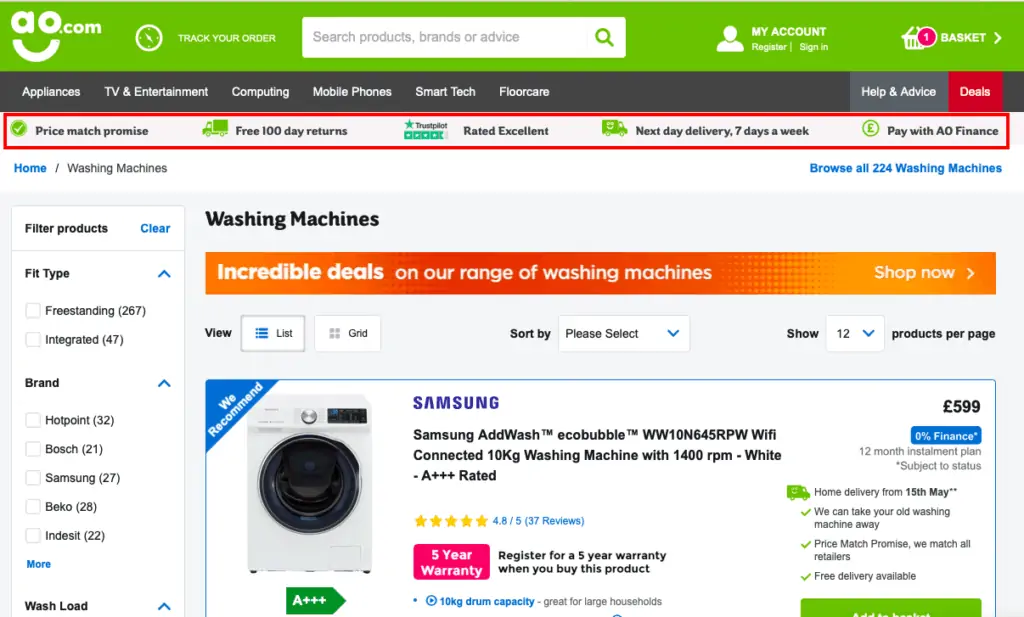Once potential customers have clicked on your search ads, landing pages need to help them find what they’re looking for, and persuade them to buy from your site.
In this article, we’ll look at tips on improving PPC landing pages, borrowed from Dan Barker’s insightful Twitter thread.
What kind of landing page should ads lead users to?
Most online retailers organise PPC landing pages around the product hierarchy, with different pages depending on the type of search term.
So, core and brand search terms will be used to send searchers to the homepage, in the same way that an organic brand search would.
Category terms, such as ‘women’s dresses’ will send shoppers to that product category page, where they can begin to sort and filter from the options presented.
So an ad like this…
… sends people who click through to a page like this:
Sub-category pages work in a similar way, while in the case searches for a brand of product (Adidas trainers for example), sites will often show a landing page around that brand and category, like this one from JD Sports.
In addition, if a customer is specific about a certain product facet, size for example, then it pays to show them only those sizes to narrow down their product selection when they reach your site.
This is all about trying to be as relevant as possible to the search term the ad appears next to, while providing choice to the shopper that lands on your site.
Presentation of landing pages
Google Shopping ads will normally take shoppers to individual products, most text ads go to pages containing multiple products related to the term, as in the examples above.
This raises the question of how to arrange the page to help the user find what they want, and to show products the retailer wants to push.
It can help if the landing page is
- Sorted so that best-sellers are at the top, to appeal to a broad mix of customers.
- Or includes a mix of products shown prominently that would appeal to different customer types.
Other products worth placing in a prominent position include:
- Products with good reviews.
- Seasonal best sellers.
- Evergreen products that continually convert well.
- A mix of different brands.
- A mix of facets for broad terms (t-shirts, shoes etc)
- A mix of prices – cheap, mid range and relatively expensive.
Here, for a search on ‘laptops’, Curry’s highlights four laptops, ranging from £379 to £699, all with high review scores.
Tools to include on landing pages
When users are sent to pages with multiple products, it’s useful to include features which help them to make sense of the page, and which help them to choose items.
These features include an indication of where the user has landed in the site.
Breadcrumb trails like this from JD Sports help, as do the filters already selected to match the PPC ad, and give the user a useful starting point.
Showing trust indicators on landing pages can help too. These include reviews, testimonials and social proof like number of customers or social followers.
Here, AO.com uses an offer / USP bar which highlights reviews from Trustpilot as well as key selling points like free returns and finance options.

It’s also useful to allow uses to filter the product selection further, as AO.com does in the example above, showing extra filters like brand, wash load, price and more.
These options allow users to choose features which suit them, and make the selection more relevant to them.
Target email signups as well as sales
Many sites now target new visitors with a call to action to sign up for marketing emails. It’s become a bigger priority for some sites to try and get visitors onto mailing lists rather than to sell to them there and then.
It can make sense, if retailers feel they’re more likely to sell to a customer on an email list than on their first visit. The generosity of some of the offers may also encourage them to make a purchase, as with this 25% off incentive from New Look.
Some of these messages can be oushy, and could deter visitors, so timing is important.
These email sign ups have become common as sites tend to copy each other, but also thanks to the growth of traffic to retailers from mobile.
The theory is that desktop browsers are more likely to be in buying mode, while mobile visitors may be passing time on the bus or in a coffee shop, more in browsing mode. Email signups make sense in this context as they provide an option to ‘remind’ shoppers of their visit later.
Measure email signups from landing pages
When measuring PPC performance, retailers can focus purely on sales generated from ads. This is clearly important, but it can be useful to measure the number of email signups as an outcome.
This helps to maximize the results from this channel, and allows credit to be properly applied to PPC activity which would otherwise be missed.
For example, you could segment certain email signups as ‘PPC acquired’ to see if they’re more or less valuable in the long term.
Show multiple products on landing pages for shopping ads
Often Shopping ads take users to individual product pages. These pages may match the search term to some extent, but aren’t always the exact product that people were searching for.
This is one of the landing pages from the ‘blue shirt’ search example shown above.
It takes users to a page with a blue shirt, but in the case of such a broad search term, it may have been more useful to show a range of blue shirts on the landing page.
